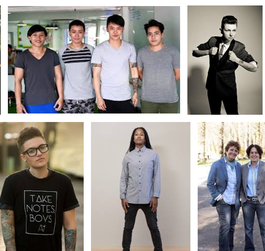 Jameka Evans was a security guard at Georgia Regional Hospital in Savannah, Georgia. From the beginning of her employment in 2012, Evans was treated badly. She was harassed verbally and physically; she was criticized for wearing a "male" uniform and having a short haircut, and for not carrying herself in a "traditional woman[ly] manner." In short, she was being harassed for both her gender presentation and her sexual orientation. Evans left her job about a year later, sick of the constant harrassment, and filed a complaint under a federal law known as "Title VII." Title VII prevents discrimination on the basis of sex, including sex stereotyping. The case went to a federal district court, where she lost because the court said that Title VII was intended to protect "sex," not "homosexuality." Evans then appealed to the next court up (the 11th Circuit, since she lives in Georgia), saying that Title VII prevented discrimination against her on the basis of sexual orientation and gender presentation. That court, too, ruled against her (and as a Slate article pointed out, the ruling was weird in a variety of ways). The court separated the gender nonconformity part from the sexual orientation part. They vacated (basically overturned, but without creating precedent) that part of the district court's order, saying that she could go back and try with that part of the case again. Evans and her lawyers then asked for something called an "en banc" hearing, which means that instead of the usual three-judge panel, all the judges on the 11th Circuit would have heard the case. This was denied, meaning that the ruling against Evans stands--at least, until the U.S. Supreme Court says otherwise. So Evans, represented by Lambda Legal, decided to petition the Supreme Court to hear the sexual orientation part of the case. The petition (which you can download from this site if you're interested) is terrific, clearly explaining why discrimination on the basis of sexual orientation is a form of gender discrimination. It states, "It cannot be that Title VII allows an employer to fire Sharon for exercising her constitutional right to marry her girlfriend while retaining her co-worker Samuel after he marries his." Will the Supreme Court take the case? Who knows. But I suspect it will, since nearly all the circuits have weighed in, there's a circuit split (thanks to the 11th Circuit), and it's an important issue. To go back to the gender nonconformity piece for a minute: it's kind of interesting: Title VII definitely applies to "sex stereotyping" (as the Supreme Court decided in a 1989 case called Price Waterhouse v. Hopkins), which is what courts rely on to explain that gender nonconformity is covered. Which would seem to mean that trans people are definitely covered, right? So if the Supreme Court ruled against Evans, a few things would happen that seem like sort of untenable outcomes:
Anyhow, it's an exciting case with huge implications. Keep an eye on this one, dear readers.
1 Comment
 Some results of a Google image search of the words "butch" and "trans" Some results of a Google image search of the words "butch" and "trans" I was having drinks with a friend the other night, and as often seems to be the case with lesbians these days, we fell into a discussion about the relative prevalence of trans men now as compared to, say, 10 or 15 years ago. My friend’s question was: why now? Why are there so many trans men, particularly young ones, at this moment in time? My first response was a version of the “backlog” argument I made a few years ago on this blog: trans men have always been around; it’s just that a more extensive physical transition was less available until recently, so many of them chose to live as butch lesbians. My friend didn’t buy it. Her arguments were: (1) It’s still expensive to transition, so it’s not like it’s that “available” now compared to 10 years ago, and (2) There have always been people born as women who identified as men and lived as men. She’s right about both, I suppose--although I'm certain that hormones, trans-positive therapists, etc., are a lot more prevalent than they used to be. (Maybe are we wrong and there aren't more trans men, just more trans visibility? But I don't think we're wrong.) Or, perhaps it is not about scientific or hormonal or surgical availability; perhaps it is about cultural availability. Perhaps it used to be the case that someone born a woman who identified as masculine didn’t used to have models for what a transition was like, or a community that would be accepting, or—and this is crucial—the internet as a trove of resources and potential connections. Perhaps this lack of “cultural availability” made it more difficult, because even though transitioning is hard now, maybe it was a lot more isolating back then. I feel like it had to have been. So I guess that's still a "backlog" argument, but a different kind of backlog argument. Another possible explanation is that there has been a resurgence of gender essentialism—maybe it just seems way more comfortable and plausible to live as a gender-conforming man than as a gender nonconforming woman. As my friend told me, “Lesbians have never been in fashion.” True enough (although we have our flashes of hip visibility every now and again—see, e.g., Rachel Maddow on the cover of Rolling Stone). But it’s not like trans men are “in fashion” in a mainstream sense either—I’m hard-pressed to think of trans men with Maddow-level visibility. Then again, trans men are men, and often pass as cis men to everyone around them—and men have always been in fashion. So maybe if you don’t have a strong sense that you were born in the wrong body (I know that many people do—I’m talking about those who don’t), but you know you’re masculine, it’s psychologically more comfortable to be a guy. I don’t know. I don’t have a good answer to my friend’s question, and I thought it was kind of an uninteresting question in the moment (duh—the backlog thing + scientific advances). But the more I think about it, the more I think it’s a good question. Why now? |
|

 RSS Feed
RSS Feed